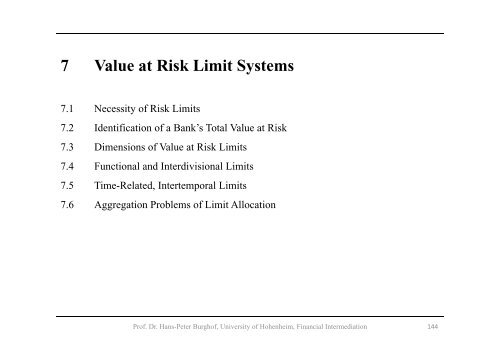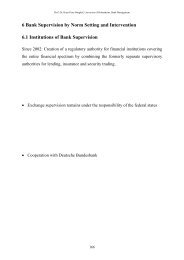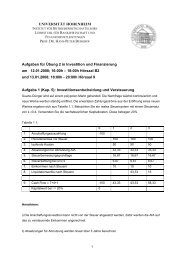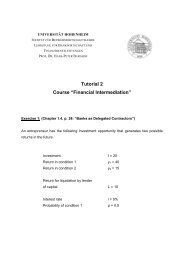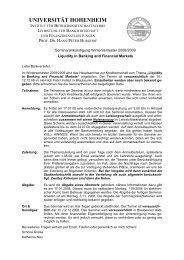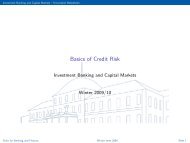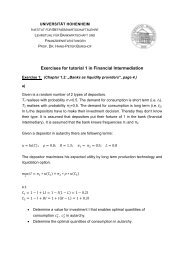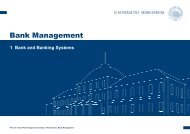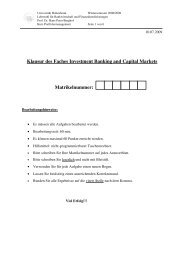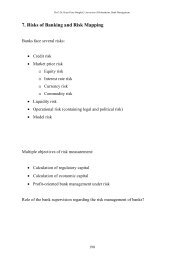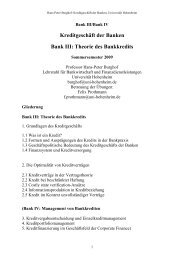7 Value at Risk Limit Systems
7 Value at Risk Limit Systems
7 Value at Risk Limit Systems
Create successful ePaper yourself
Turn your PDF publications into a flip-book with our unique Google optimized e-Paper software.
7 <strong>Value</strong> <strong>at</strong> <strong>Risk</strong> <strong>Limit</strong> <strong>Systems</strong><br />
7.1 Necessity of <strong>Risk</strong> <strong>Limit</strong>s<br />
7.2 Identific<strong>at</strong>ion of a Bank’s Total <strong>Value</strong> <strong>at</strong> <strong>Risk</strong><br />
7.3 Dimensions of <strong>Value</strong> <strong>at</strong> <strong>Risk</strong> <strong>Limit</strong>s<br />
7.4 Functional and Interdivisional <strong>Limit</strong>s<br />
7.5 Time-Rel<strong>at</strong>ed, Intertemporal <strong>Limit</strong>s<br />
7.6 Aggreg<strong>at</strong>ion Problems of <strong>Limit</strong> Alloc<strong>at</strong>ion<br />
Prof. Dr. Hans-Peter Burghof, University of Hohenheim, Financial Intermedi<strong>at</strong>ion 144
7.1 Necessity y of <strong>Risk</strong> <strong>Limit</strong>s<br />
Derives from the internal and regul<strong>at</strong>ory request th<strong>at</strong> risks have to be covered<br />
with equity. q y<br />
Therefore, financial resources for risk coverage have to be alloc<strong>at</strong>ed to the<br />
particular business units. This alloc<strong>at</strong>ion is done by defining risk limits (resp.<br />
VaR limits).<br />
Moreover, risk cluster should be avoided. Within a risk limit system, e.g. for<br />
market risks, limits for interest r<strong>at</strong>e risks, foreign exchange risks and stock price<br />
risks are conceivable.<br />
Inform<strong>at</strong>ion and specific knowledge about the risks of the particular business<br />
units exist primarily in this units, thus the deleg<strong>at</strong>ion of decision-making<br />
authority to lower management levels is important.<br />
Central risk alloc<strong>at</strong>ion according to VaR limits guarantees th<strong>at</strong> a bank’s total risk<br />
position does not exceed her risk bearing capacity.<br />
Prof. Dr. Hans-Peter Burghof, University of Hohenheim, Financial Intermedi<strong>at</strong>ion 145
7.2 Identific<strong>at</strong>ion of a Bank’s Total <strong>Value</strong> <strong>at</strong> <strong>Risk</strong><br />
<strong>Risk</strong> Bearing Capacity of a Bank<br />
The risk bearing capacity is defined as the maximum loss the bank can handle<br />
without thre<strong>at</strong>ening the bank’s further existence; this loss should not be exceeded<br />
under no circumstances.<br />
Its level depends mainly on the equity capitaliz<strong>at</strong>ion of a bank.<br />
The risk bearing capacity as defined above goes beyond the officially reported<br />
equity and the regul<strong>at</strong>ory equity requirements and includes, for instance, parts of<br />
the oper<strong>at</strong>ional results and other valu<strong>at</strong>ion reserves in the bank’s assets.<br />
Prof. Dr. Hans-Peter Burghof, University of Hohenheim, Financial Intermedi<strong>at</strong>ion 146
Classific<strong>at</strong>ion of <strong>Risk</strong> Capital and <strong>Risk</strong> Bearing Capacity<br />
The total VaR limit is set up once a year and presents the origin for the bank’s<br />
risk limit system.<br />
<strong>Risk</strong> Capital Source<br />
Primary <strong>Risk</strong> Capital Excess Profits<br />
Secondaryy <strong>Risk</strong> Capital p<br />
Inner Reserves<br />
Tertiary <strong>Risk</strong> Capital Minimum Profit<br />
Common Stock<br />
Quarternary <strong>Risk</strong> Capital Open Reserves<br />
Quintary <strong>Risk</strong> Capital<br />
Special Items for Common Bank <strong>Risk</strong>s<br />
Tier 2 Capital (Without Inner Reserves)<br />
Tier 3 Capital<br />
Prof. Dr. Hans-Peter Burghof, University of Hohenheim, Financial Intermedi<strong>at</strong>ion 147
<strong>Risk</strong> Preferences of a Bank<br />
Which sources of the risk bearing capacity are included in the indentific<strong>at</strong>ion of<br />
the risk capital/the total value <strong>at</strong> risk limits, depends on the risk preferences of<br />
the bank management.<br />
But the risk capital should only be a subset of the risk bearing capacity of a bank<br />
and should generally not exceed the l<strong>at</strong>ter.<br />
The identific<strong>at</strong>ion of the level of the total value <strong>at</strong><br />
risk limit of a bank is mainly depending on the risk<br />
bearing capacity and the risk preference.<br />
Prof. Dr. Hans-Peter Burghof, University of Hohenheim, Financial Intermedi<strong>at</strong>ion 148
7.3 Dimensions of <strong>Value</strong> <strong>at</strong> <strong>Risk</strong> <strong>Limit</strong>s<br />
For the following explan<strong>at</strong>ion, a theoretical distinction between two dimensions<br />
is helpful.<br />
But: from a practical point of view and according to an efficient risk limit<strong>at</strong>ion<br />
and risk adjustment, an integr<strong>at</strong>ed consider<strong>at</strong>ion is required.<br />
Functional, interdivisional limits:<br />
Efficient distribution of a given total<br />
risk limit to business units/profit<br />
center/portfolios... in terms of value <strong>at</strong><br />
risk ikli limits. i<br />
li limit i addressee. dd<br />
Time-rel<strong>at</strong>ed, intertemporal limits:<br />
Temporal dynamic adjustment of the<br />
value <strong>at</strong> risk limits according to the<br />
current P&L situ<strong>at</strong>ion of the relevant<br />
“Passive” risk limit<strong>at</strong>ion “Active” risk management<br />
Prof. Dr. Hans-Peter Burghof, University of Hohenheim, Financial Intermedi<strong>at</strong>ion 149
7.4 Functional, Interdivisional <strong>Limit</strong>s<br />
Breakdown/Distribution of the Total <strong>Value</strong> <strong>at</strong> <strong>Risk</strong> <strong>Limit</strong>s<br />
At first, the total value <strong>at</strong> risks limits have to be distributed to the bank’s<br />
most important risk c<strong>at</strong>egories.<br />
It is common to distinguish <strong>at</strong> least between market price risks and<br />
counterparty risks. Furthermore, oper<strong>at</strong>ional risks, liquidity risks and<br />
str<strong>at</strong>egic risks are possible.<br />
Th Then, th there is i a further f th breakdown b kd of f limits li it ffor e.g. market ktrisks ik in i interest it t<br />
r<strong>at</strong>e risks, foreign exchange risks, stock price risks and commodity risks.<br />
Now Now, these limits are broken down and distributed further to business units<br />
and within these even on individual persons (most likely on traders in the<br />
area of market risks).<br />
risks)<br />
Prof. Dr. Hans-Peter Burghof, University of Hohenheim, Financial Intermedi<strong>at</strong>ion 150
The following figure is supposed to illustr<strong>at</strong>e the prinicipal organis<strong>at</strong>ion<br />
of a limit structure, structure as described above:<br />
Stock Price <strong>Risk</strong>s<br />
30 Mio. €<br />
Market Price <strong>Risk</strong>s<br />
80 Mio. €<br />
Unit<br />
8 Mio. €<br />
TTotal lVl <strong>Value</strong> <strong>at</strong> Ri <strong>Risk</strong> k Li <strong>Limit</strong> i<br />
200 Mio. €<br />
…<br />
Foreign Exchange<br />
<strong>Risk</strong>s 20 Mio. €<br />
… Team<br />
3 Mio. €<br />
Counterparty <strong>Risk</strong>s<br />
100 Mio. €<br />
… … …<br />
Interest R<strong>at</strong>e <strong>Risk</strong>s<br />
40 Mio. €<br />
… Trader<br />
1 Mio. €<br />
…<br />
Commodity <strong>Risk</strong>s<br />
10 Mio. €<br />
Prof. Dr. Hans-Peter Burghof, University of Hohenheim, Financial Intermedi<strong>at</strong>ion 151<br />
…
CConsider<strong>at</strong>ion id ti of f CCorrel<strong>at</strong>ions l ti<br />
FFor th the li limit it distribution, di t ib ti all ll oper<strong>at</strong>ional ti l business b i units it hhave tto be b interpreted i t t d as<br />
one portfolio.<br />
The total value <strong>at</strong> risk limit has to be divided between the risk capital<br />
addressees according to the correl<strong>at</strong>ion of the potential loss factors.<br />
Hence Hence, diversific<strong>at</strong>ion effects in the total portfolio must be considered considered.<br />
With regard of the correl<strong>at</strong>ions, the sum of the individual value <strong>at</strong> risk limits<br />
VL i of all different business units n is equal to or gre<strong>at</strong>er than the total value <strong>at</strong><br />
risk limit VL total :<br />
n<br />
<br />
i1<br />
VL<br />
i<br />
VL <br />
total<br />
Prof. Dr. Hans-Peter Burghof, University of Hohenheim, Financial Intermedi<strong>at</strong>ion 152
Regarding the limit structure illustr<strong>at</strong>ed above, above one recognizes th<strong>at</strong> the sum<br />
of the limits per market risk c<strong>at</strong>egory (100 million €) exceed the particular<br />
total value <strong>at</strong> risk limit (80 million €) for this unit .<br />
This can appears between each level of limit structures when considering<br />
correl<strong>at</strong>ions.<br />
The conserv<strong>at</strong>ive manner of disregarding the risk compens<strong>at</strong>ing effects of<br />
correl<strong>at</strong>ion leads to lower value <strong>at</strong> risk limits on subordin<strong>at</strong>e levels.<br />
Such an alloc<strong>at</strong>ion leads to an under-utiliz<strong>at</strong>ion of limits on higher levels of<br />
aggreg<strong>at</strong>ion; th<strong>at</strong> is not conform to an efficient alloc<strong>at</strong>ion (in terms of risk<br />
adjusted performance measures).<br />
Prof. Dr. Hans-Peter Burghof, University of Hohenheim, Financial Intermedi<strong>at</strong>ion 153
Functionality of a <strong>Limit</strong> System<br />
The functionality of a limit system is based on the following restriction:<br />
every single transaction can only be executed within the scope of a value<br />
<strong>at</strong> risk ikli limit, i if there h iis a li limit i for f this hi kind ki d of f transactions i th<strong>at</strong> h captures the h<br />
potential loss of th<strong>at</strong> transaction with high probability.<br />
Withi Within the th given i value l <strong>at</strong> t risk i k li limits, it all ll business b i units it are allowed ll d tto<br />
execute deals freely and self dependent.<br />
But it must be secured th<strong>at</strong> all transactions are taken into account of the<br />
corresponding limits immedi<strong>at</strong>ely.<br />
The peripherally acting persons need to know their personal value <strong>at</strong> risk<br />
limits AND its current utiliz<strong>at</strong>ion.<br />
Prof. Dr. Hans-Peter Burghof, University of Hohenheim, Financial Intermedi<strong>at</strong>ion 154
Viol<strong>at</strong>ion of <strong>Limit</strong>s<br />
Actions in the case of limit viol<strong>at</strong>ions are different according to the affected<br />
management level.<br />
A viol<strong>at</strong>ion on a subordin<strong>at</strong>e level, e.g. a trader’s limit viol<strong>at</strong>ion, can be toler<strong>at</strong>ed if<br />
th the value l <strong>at</strong> t risk i k limit li it on a higher hi h level l l (team (t or bbusiness i unit it level) l l) is i not t in i<br />
danger.<br />
But if a limit on a critical level is viol<strong>at</strong>ed (according to the bank’s risk profile), the<br />
senior management must define further proceedings.<br />
proceedings<br />
Prof. Dr. Hans-Peter Burghof, University of Hohenheim, Financial Intermedi<strong>at</strong>ion 155
In the following, some proceedings for limit viol<strong>at</strong>ions are illustr<strong>at</strong>ed<br />
for market risks:<br />
The affected limit is<br />
viol<strong>at</strong>ed shortly.<br />
Some other<br />
unaffected units<br />
cannot exhaust their<br />
limits completely.<br />
The affected limit is<br />
viol<strong>at</strong>ed shortly.<br />
Trading of the<br />
affected unit is<br />
cancelled temporally.<br />
The affected limit is<br />
permanently<br />
exceeded exceeded.<br />
More risk capital is<br />
admitted. More<br />
sources of the risk<br />
bearing capacity, e.g.<br />
inner reserves, are<br />
considered.<br />
The position th<strong>at</strong><br />
caused the viol<strong>at</strong>ion<br />
is closed instantly instantly.<br />
Prof. Dr. Hans-Peter Burghof, University of Hohenheim, Financial Intermedi<strong>at</strong>ion 156
Th The Alloc<strong>at</strong>ion All ti of f <strong>Risk</strong> Ri k CCapital/Total it l/T t l Vl <strong>Value</strong> <strong>at</strong> tRikLi <strong>Risk</strong> <strong>Limit</strong>s it<br />
Th The following f ll i table t bl gives i an overview i of f the th possible ibl proceedings: di<br />
Top-Down Bottom-Up Negoti<strong>at</strong>ion as an<br />
Iter<strong>at</strong>ive Process<br />
The business center<br />
simultaneously defines<br />
profit targets and the<br />
essential ti l risk i k capital it l tto<br />
achieve this targets.<br />
The feasibility y in banks<br />
is difficult, as the center<br />
does not have all<br />
detailed inform<strong>at</strong>ion<br />
about the profit p and<br />
risk situ<strong>at</strong>ion of each<br />
risk addressee.<br />
The individual<br />
addressees st<strong>at</strong>e their<br />
profit targets and the<br />
required i d amount t of f risk i k<br />
capital on their own.<br />
Here, it is essential th<strong>at</strong><br />
the addressees can<br />
estim<strong>at</strong>e their profit and<br />
risk factors realistically.<br />
There is a common<br />
negoti<strong>at</strong>ion about the<br />
admitted risk capital<br />
and dth the risk i kadjusted dj t d<br />
performance th<strong>at</strong> has<br />
to be reached.<br />
Hence Hence, the efficiency of<br />
capital utiliz<strong>at</strong>ion can<br />
be increased.<br />
This approach is very<br />
costly though.<br />
Internal Market Place<br />
The admitted risk<br />
capital and<br />
performance targets<br />
are dderived i d ffrom<br />
supply (of the center)<br />
and demand (of the<br />
risk capital<br />
addressees).<br />
dd )<br />
With this peripheral<br />
process, there is no<br />
way to define the total<br />
risk limit ex-ante.<br />
Prof. Dr. Hans-Peter Burghof, University of Hohenheim, Financial Intermedi<strong>at</strong>ion 157
IIn reality, li there h is i often f a mixture i between b the h first fi three h methods. h d<br />
PPartly, tl there th are alloc<strong>at</strong>ion ll ti processes which hi h are not t yet tstringent t i t and d structured. t t d<br />
The reason for th<strong>at</strong> is th<strong>at</strong> the risk alloc<strong>at</strong>ion cannot be based on a method like<br />
capital budgeting or net present value calcul<strong>at</strong>ion.<br />
Cash flow forecasting for one year is much more difficult for a trading unit than<br />
for a classical investment project.<br />
To meet the standards of an efficient risk capital p alloc<strong>at</strong>ion, , RAPM and share<br />
holder value aspects shall always be taken into account.<br />
Prof. Dr. Hans-Peter Burghof, University of Hohenheim, Financial Intermedi<strong>at</strong>ion 158
7.5 Time-Rel<strong>at</strong>ed, Intertemporal <strong>Limit</strong>s<br />
Time i Reference f of f<strong>Value</strong> <strong>at</strong> <strong>Risk</strong> i <strong>Limit</strong>s, i i Using i the Example of fTrading i Units i<br />
UUsually, ll a value l <strong>at</strong> t risk i k limit li it is i admitted d itt d for f one year, although lth h trading t di str<strong>at</strong>egies t t i<br />
are often pursued for shorter periods, e.g. for one day.<br />
Hence Hence, a time time-rel<strong>at</strong>ed rel<strong>at</strong>ed disaggreg<strong>at</strong>ion of annual value <strong>at</strong> risk limits is needed as the<br />
calcul<strong>at</strong>ion period of this limit does not m<strong>at</strong>ch the one-day holding period of the<br />
trading position. position<br />
Thus, the value <strong>at</strong> risk of the trading position cannot be subtracted from the<br />
annual value <strong>at</strong> risk limit as both values are incomparable.<br />
The value <strong>at</strong> risk of a trading position is calcul<strong>at</strong>ed rel<strong>at</strong>ively too low caused by<br />
the short holding gpperiod.<br />
Prof. Dr. Hans-Peter Burghof, University of Hohenheim, Financial Intermedi<strong>at</strong>ion 159
HHence, the h question i comes up, which hi hvalue l <strong>at</strong> risk i kli limit i is i available il bl ffor a subperiod, b i d<br />
especially for one day.<br />
To transl<strong>at</strong>e an annual into a one day value <strong>at</strong> risk limit, the liter<strong>at</strong>ure suggests the<br />
square square-root-T-rule: root T rule:<br />
DL <br />
YL<br />
T<br />
*<br />
The one-day limit, DL, has to be computed from the annual limit YL and the square-<br />
root of T, where T is the unit of the annual limit (e.g. 250 trading days).<br />
* Simplified with the assumption of an expected daily return = 0.<br />
Prof. Dr. Hans-Peter Burghof, University of Hohenheim, Financial Intermedi<strong>at</strong>ion 160
Methods of <strong>Limit</strong> Adjustment Over Time Time, Using the Example of Trading Units<br />
A fixed limit represents the most simple case: an unchanged limit is set for the<br />
complete business year.<br />
By doing so, current dynamic profit and loss conditions of the value <strong>at</strong> risk addressee<br />
remain unconsidered.<br />
As there is no intertemporal adjustment of the value <strong>at</strong> risk limit throughout the year,<br />
there is actually no active risk management but only a risk limit<strong>at</strong>ion by the annual<br />
limit.<br />
Prof. Dr. Hans-Peter Burghof, University of Hohenheim, Financial Intermedi<strong>at</strong>ion 161
Hence, there is only a transition of the annual limit into a daily limit according to<br />
square-root-T-rule.<br />
YL<br />
DL FL with FL = fixed f limit<br />
T<br />
For instance, there are T = 250 trading days and an annual limit of 2 million €,<br />
then the daily limit equals 126.491,11 €<br />
Prof. Dr. Hans-Peter Burghof, University of Hohenheim, Financial Intermedi<strong>at</strong>ion 162
AApplying l i the h second d method, h d the h lloss li limit<strong>at</strong>ion it ti li limit, it the h trader d calcul<strong>at</strong>es l l with i h<br />
the whole annual limit of (e.g.) 2 million € from the very first trading day on. But<br />
thi this limit li it is i not t available il bl to t him hi daily. d il<br />
Realized losses over time reduce the annual limit for the following days of the<br />
year; realized profits can increase the VaR limit to the initial value of 2 million €.<br />
Regular accounting for losses cuts down the trader’s scope of activities.<br />
Accounting for profits can only happen if there had been limit cuts due to losses<br />
so far.<br />
Prof. Dr. Hans-Peter Burghof, University of Hohenheim, Financial Intermedi<strong>at</strong>ion 163
Additionally Additionally, there is the opportunity to compens<strong>at</strong>e losses with realized past<br />
profits. Hence, one can “save” for future losses.<br />
The profits or losses (market value changes) in t are derived from:<br />
LL<br />
t Vt<br />
1<br />
VL<br />
Vt 1<br />
V R<br />
t<br />
with LL = loss limit.<br />
stands for the invested position from t-1 to t and R t for the daily returns.<br />
KV<br />
The accumul<strong>at</strong>ed profits or losses, , which occur between the first trading<br />
day of the year t=1 till t are calcul<strong>at</strong>ed as follows:<br />
t<br />
LL<br />
LL<br />
KVt Vt<br />
s1<br />
Vt<br />
1<br />
Rt<br />
...<br />
V0<br />
<br />
s1<br />
LL<br />
where V0 is the amount of money invested between t=0 (the last trading<br />
day of the old year) and t=1 (the first trading day of the new year).<br />
t<br />
Prof. Dr. Hans-Peter Burghof, University of Hohenheim, Financial Intermedi<strong>at</strong>ion 164<br />
R<br />
t
The h annual lvalue l <strong>at</strong> risk i kli limit, i YL LL<br />
t , computed d iin t equals l YL if<br />
KVt 0<br />
t V K YL <br />
0 K Vt<br />
and , if .<br />
YL defines the initial value <strong>at</strong> risk limit (2 million €) admitted <strong>at</strong> the<br />
beginning of the year.<br />
The daily value <strong>at</strong> risk limit th<strong>at</strong> is available to the trader in t+1 is<br />
computed p by y the square-root-T-rule q again: g<br />
DL<br />
LL <br />
YLt<br />
T<br />
LL<br />
Prof. Dr. Hans-Peter Burghof, University of Hohenheim, Financial Intermedi<strong>at</strong>ion 165
Th The third hi d method, h d the h ddynamic i limit, li it iis equal l to the h lloss limit<strong>at</strong>ion li i i limit, li i whereas h<br />
the available annual limit can exceed the 2 million € level by accounting for profits.<br />
Hence, the scope of the trader’s activities can be limited but it can also be enlarged<br />
infinitely (theoretically).<br />
(theoretically)<br />
YL<br />
YL K Vt<br />
with<br />
DL<br />
t<br />
KVt t<br />
DL<br />
DL<br />
Vt<br />
s1<br />
Vt<br />
1<br />
Rt<br />
...<br />
V0<br />
Rt<br />
s1<br />
The annual value <strong>at</strong> risk limit limit, , th<strong>at</strong> is the basis for the trader’s trader s calcul<strong>at</strong>ion calcul<strong>at</strong>ion, is:<br />
YL <br />
DL<br />
t<br />
where V 0 DL is the amount invested on the last trading day of the passed year (t=0).<br />
The daily value <strong>at</strong> risk limit is calcul<strong>at</strong>ed as follows:<br />
DL<br />
DL <br />
YLt<br />
T<br />
DL<br />
Prof. Dr. Hans-Peter Burghof, University of Hohenheim, Financial Intermedi<strong>at</strong>ion 166
7.6 Aggreg<strong>at</strong>ion Problems of <strong>Limit</strong> Alloc<strong>at</strong>ion<br />
Two main aggreg<strong>at</strong>ion problems have to be solved in the value <strong>at</strong> risk model as well<br />
as in a value <strong>at</strong> risk limit system.<br />
The aggreg<strong>at</strong>ion of value <strong>at</strong> risk limits over the complete hierarchical limit structure<br />
respectively over the “limit portfolio”.<br />
The aggreg<strong>at</strong>ion of value <strong>at</strong> risk limits over time (intertemporal scaling).<br />
Each problem can be alloc<strong>at</strong>ed to one particular VaR limit<strong>at</strong>ion dimension mentioned<br />
above, which actually have to be viewed integr<strong>at</strong>ed in practice; th<strong>at</strong> brings up even<br />
more problems.<br />
Prof. Dr. Hans-Peter Burghof, University of Hohenheim, Financial Intermedi<strong>at</strong>ion 167
Problems of Integr<strong>at</strong>ing Both Dimensions of <strong>Value</strong> <strong>at</strong> <strong>Risk</strong> <strong>Limit</strong>s<br />
The mentioned models for VaR limit<strong>at</strong>ion over time are only viable for one<br />
particular limit addressee.<br />
Within a hierarchical limit structure, the adjustment of individual value <strong>at</strong> risk limits<br />
cannot be done without interdependency p y effects on the whole value <strong>at</strong> risk limit<br />
system.<br />
If the value <strong>at</strong> risk limit of an addressee changes due to risk management actions, the<br />
aggreg<strong>at</strong>ed value <strong>at</strong> risk limit changes immedi<strong>at</strong>ely, too (ceteris paribus).<br />
This can lead to an over-utiliz<strong>at</strong>ion of the formerly utilized total value <strong>at</strong> risk limit.<br />
Prof. Dr. Hans-Peter Burghof, University of Hohenheim, Financial Intermedi<strong>at</strong>ion 168
In a complex limit structure, the value <strong>at</strong> risk limits should never be adjusted on<br />
low hierarchy limit levels.<br />
Because of the correl<strong>at</strong>ions between the portfolios of the different limit addressees,<br />
the h risk i kmanagement actions i according di to the h oper<strong>at</strong>ing i results l must bbe executed d on<br />
the highest level of aggreg<strong>at</strong>ion, th<strong>at</strong> is, on the total value <strong>at</strong> risk limit.<br />
Hence, this imper<strong>at</strong>ively leads to a reconstruction of the value <strong>at</strong> risk limit system<br />
respectively to a realloc<strong>at</strong>ion of the modified risk capital. capital<br />
Finally Finally, due to the consider<strong>at</strong>ion of the oper<strong>at</strong>ing results results, the profitability of the<br />
limit addressees changes.<br />
Prof. Dr. Hans-Peter Burghof, University of Hohenheim, Financial Intermedi<strong>at</strong>ion 169
How Frequently Should/Could a Realloc<strong>at</strong>ion of <strong>Risk</strong> Capital Be Executed?<br />
A continuous value <strong>at</strong> risk limit management in combin<strong>at</strong>ion with a continuous<br />
realloc<strong>at</strong>ion of all value <strong>at</strong> risk limits surely fails because of the<br />
technical/m<strong>at</strong>hem<strong>at</strong>ical feasibility.<br />
A steady y confront<strong>at</strong>ion of the trading g units with new limits does not seem<br />
reasonable.<br />
The same holds for a daily or weekly complete reconstruction of the limit system.<br />
Prof. Dr. Hans-Peter Burghof, University of Hohenheim, Financial Intermedi<strong>at</strong>ion 170
Modific<strong>at</strong>ions should r<strong>at</strong>her be executed if ongoing changes in the results and the<br />
profitability of trading units become apparent. apparent<br />
More realistic is a monthly or quarterly reconstruction of the value <strong>at</strong> risk limit<br />
system.<br />
In the short run, the methods of intertemporal limit management could be executed<br />
within predefined tolerance ranges by the corresponding limit addressees.<br />
Prof. Dr. Hans-Peter Burghof, University of Hohenheim, Financial Intermedi<strong>at</strong>ion 171


